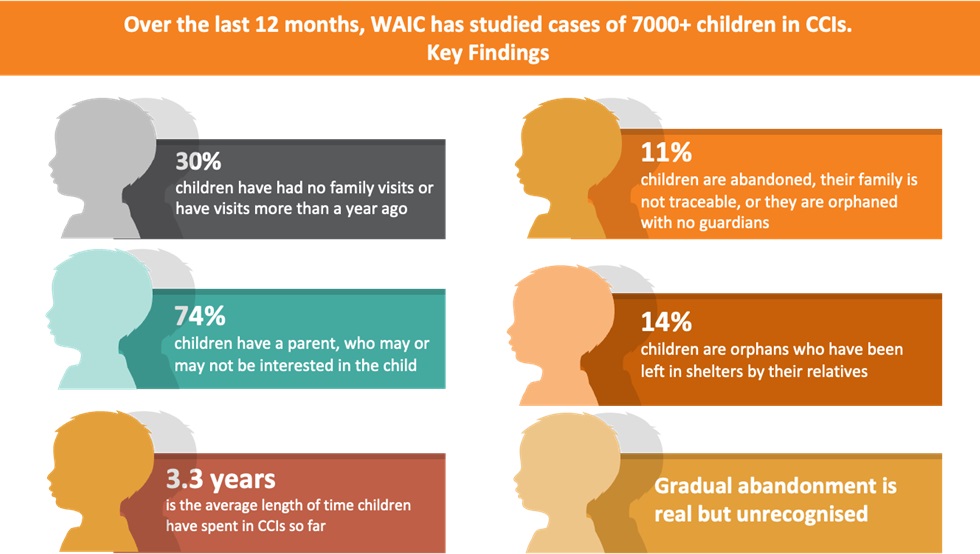Silent And Stuck: The Crisis Of The Shelter Children In Limbo

Pune, 27th January 2024: The sun was setting as young Kumari (name changed) settled down on her mat among other children to sleep at the Child Care Institution (aka child shelter) she had come to know as home over the years. Her story, though unique in its details, echoes the haunting refrain of many children within India’s shelters.
Orphaned early on, losing both of her parents to sickness, Kumari biological relatives were unable to look after her so her aunt Nalini (name changed) placed her in a child shelter. Kumar was shuffled from one shelter to another as she grew older. Emotionally, she became detached as she watched other children at the shelter come and go, some of them reunited with biological families and others celebrating their adoption by adoptive families. Eight years went by and nobody ever visited nor came for Kumari, leaving her to wonder if she was truly forgotten by everyone.
“Almost every day, she’d ask if anyone was going to come for her. Her hopeful eyes searching for a family, a connection,” recalls a caretaker from the institution. Kumari was not placed in the legal adoption pool because she had relatives on paper, even if they never cared for her in real life.
All over India, stories like Kumari’s reveal a silent, overlooked crisis. In a small village on the outskirts of Maharashtra, two sisters, aged 9 and 11 respectively, found themselves grappling with a heart-wrenching reality. Their laughter, once echoing through their family home, now resonates within the walls of a children’s shelter. Their mother, after the tragic demise of their father, found solace in another relationship and remarried. Hopes of a blended family were quickly shattered when their new stepfather showed no interest in integrating the girls into their new family. While their mother’s visits became sporadic at first, they soon ceased entirely. Days turned into weeks, weeks into months, and the shelter became the only world the sisters knew. Despite their palpable longing to belong to a loving home, lack of clear laws around their gradual abandonment has kept them trapped in a system, unable to join the legal adoption pool, and thereby, kept away from the embrace of a family that might cherish and love them.

“People think shelters house only orphans, but the reality is many kids have families, who, though not strictly orphaned, are effectively abandoned. We see cases where families have left the children for care, and do not visit them but either do not want to surrender the child for adoption or are not aware of the fact that there is an option for these children to be adopted by waiting families. It leaves them in a heart-wrenching limbo,” says Protima Sharma, Co-founder and Director of Where Are India’s Children.
The gradual abandonment quandary
A study by Where Are India’s Children unveiled the disturbing trend: 80-85% of kids in Shelters have living parents or relatives. Yet, the very fact of having relatives means that many are trapped in a system that doesn’t recognize their silent abandonment. Numerous children, left in shelters by parents or relatives, whittle away their days, months, and years waiting for a sign of love and connection.
Advocating for every child’s right to a family
NGO Where Are India’s Children (WAIC) has emerged as a beacon of hope in this darkness. Advocating for legal recognition and the rights of these ‘in-between’ children, WAIC has been pushing to get them rightfully introduced into the adoption pool. “Change is not just about policy amendments; it’s about ensuring that these policies are put into action. Every child deserves the love and warmth of a family,” asserts Meera Marthi, Co-Founder and CEO of WAIC.
While some legal guidelines are in place to support cases of gradual abandonment, in practice they are not always implemented or understood on the ground. The Juvenile Justice Model Rules of 2022 brings hope, highlighting provisions like Section 12, urging child care officials to ensure children, irrespective of their age and guardianship status, be considered for adoption. Meera voiced her concerns, stating, “The 2022 amendments are a step forward, but the onus lies with individual States to define and enforce these provisions effectively. It’s pivotal that every child’s right to a family is not just recognised but actively pursued. Our commitment is unwavering; we’ll continue to champion these young souls, campaigning for legislative change, urging for clarity, permanency hearings, and periodic reviews, ensuring no child feels forgotten.”
WAIC’s legislative change campaign focuses on defining abandonment under neglect and cruelty, terminating parental or guardian rights in cases of prolonged absence or abuse, and mandating minimum visitation requirements to expedite the adoption process for unvisited children. Central to these reforms is the ‘Right to Family’ principle, advocating for family-based care over institutionalisation and enforcing regulations for Child Care Institutions (CCIs) to be officially recognized and linked with Specialized Adoption Agencies (SAAs). These comprehensive changes proposed by WAIC aim to ensure a more nurturing and stable environment for every child in the system. The sentiments are gaining traction among stakeholders, with the Supreme Court recently ruling that children living in child care institutions (CCI), whose parents have not visited them for over a year or have “unfit” parents or guardians, should be identified and brought into the adoption pool.
The question remains: Will the collective conscience of law, state, and society rise to ensure that no child’s right to family is left in the shadows?
This series is brought to you by WAIC and seeks to shed light on the challenges vulnerable children are facing in India.
To learn more and support WAIC’s mission, visit WAIC.





